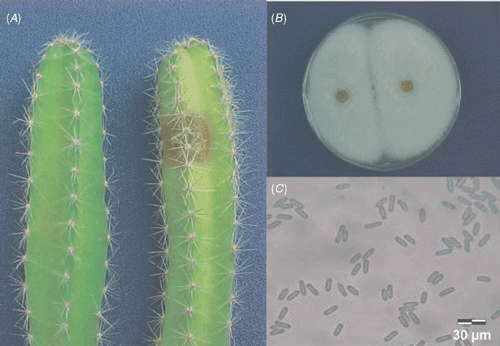First report of Colletotrichum gloeosporioides on Hylocereus megalanthus in Brazil
L. M. Takahashi A , D. D. Rosa A B , M. A. Basseto A , H. G. de Souza A and E. L. Furtado AA São Paulo State University, UNESP, College of Agronomic Science, FCA, Department of Plant Production, Plant-Health Protection Sector, PO Box 237, Botucatu, SP 18610-307, Brazil.
B Corresponding author. Email: ddrosa@fca.unesp.br
Australasian Plant Disease Notes 3(1) 96-97 https://doi.org/10.1071/DN08038
Submitted: 27 May 2008 Accepted: 3 July 2008 Published: 17 July 2008
Abstract
Reddish-orange spots with chlorotic halos were detected in stems and fruits of yellow pitahaya (Hylocereus megalanthus) in Botucatu region, Brazil, and Colletotrichum gloeosporioides was identified as the causal agent. This is the first Brazilian report on Colletotrichum gloeosporioides (Penz.) Penz. & Sacc leading to anthracnose in pitahaya plants.
The genus Hylocereus belongs to the family Cactaceae and comprises ~12 species. Along with the genus Selenicereus, which has eight species, it produces edible fruits known as pitahaya, pitaya or dragon fruit (Bauer 2003). The species Hylocereus megalanthus (K. Schumann ex Vaupel) Ralf Bauer (2003) is endemic to the north of South America (Nerd and Mizrahi 2002) and produces yellow pitahaya, one of the varieties most appreciated by consumers. The production of these fruits is restricted to small crop areas (Le Bellec et al. 2006).
In Brazil, there are small areas of production of yellow pitahaya, located mainly in the State of São Paulo. However, due to higher consumption of exotic fruit and its commercial value, interest in the planting and cultivation of this fruit is increasing. In this region, fruit production occurs from December to May, with average annual productivity of 14 tonnes of fruit per hectare. In recent years, farmers have reported a loss of up to 5% caused by anthracnose.
In July 2006, yellow pitahaya plants, from Botucatu region, São Paulo State, Brazil (22°53′09S and 48°26′42W), presenting reddish-orange spots with chlorotic halos in their stems (Fig. 1A) and fruits, were sent to Phytopathological Clinic, Department of Plant Production, Plant-Health Protection Sector, Agronomical Sciences College, São Paulo State University, UNESP, Botucatu, São Paulo, Brazil, for analysis.

|
Next to the spot regions, salmon-coloured spore masses were detected, besides subepidermal acervuli with setae and short, erect and simple conidiophores. Samples from tissue adjacent to spots were collected and their surfaces were sterilised through washing for 30 s in 70% ethanol, followed by 1% sodium hypochlorite for 30 s, and sterile distilled water. These samples were plated in Petri dishes containing potato dextrose agar (PDA) culture medium and incubated at 25°C, in the dark, from 3 to 10 days.
Colonies obtained from tissues had abundant growth, whitish coloration (Fig. 1B) and abundant sporulation, the colour of which varied between salmon and orange in the culture medium. Conidia were hyaline, cylindrical, unicellular and had round extremities, a mean length of 14.2 μm, ranging from 12.1 μm to 18.1 μm, and mean width of 4.2 μm, ranging from 3.6 μm to 8.2 μm (Fig. 1C). According to morphological and cultural characteristics, the isolate in PDA medium was identified as Colletotrichum gloeosporioides (Penz.) Penz. & Sacc (Sutton 1980, 1992). A complete growth inhibition of the isolate was observed in PDA culture medium with 1 µg/mL benomyl − a typical feature of C. gloeosporioides (Peres et al. 2004). The isolate obtained was stored in the Mycological Bank of São Paulo State University as MDF0025.
Koch’s postulates were used to verify the isolate’s pathogenicity. Thus, 6-month pitahaya seedlings were kept in a greenhouse at 24 ± 3°C in 5-L pots. Each of five plants was inoculated with a 4-mm-diameter disk obtained from the culture of C. gloeosporioides isolate grown in PDA for 7 days at 25°C, in the dark. Control plants received a PDA disk without the fungus. After inoculation, all plants were maintained in a wet chamber at 24 ± 3°C for 24 h and subsequently kept in an incubator at the same temperature. Fifteen days after inoculation, the original symptoms were observed on inoculated plants. The pathogen was then reisolated and a pure culture was obtained, confirming the disease aetiology. Such disease has already been reported in Florida, USA (Palmateer et al. 2007), Japan (Taba et al. 2006) and Korea (Kim et al. 2000). However, in Brazil, this is the first report of Colletotrichum gloeosporioides in yellow pitahaya (Hylocereus megalanthus).
Bauer R
(2003) A synopsis of the tribe Hylocereeae F. Buxb. Cactaceae Systematics Initiatives 17, 3–63.

Kim YH,
Jum OK,
Sung MJ,
Shin JS,
Kim JH, Jeoung MI
(2000) Occurrence of Colletotrichum stem rot caused by Glomerella cingulata on graft-cactus in Korea. Journal of Plant Pathology 16, 242–245.

Le Bellec F,
Vaillant F, Imbert E
(2006) Pitahaya (Hylocereus spp.): a new fruit crop, a market with a future. Fruits 61, 237–250.
| Crossref | GoogleScholarGoogle Scholar |

Palmateer AJ,
Ploetz RC,
van Santen E, Correll JC
(2007) First occurrence of anthracnose caused by Colletotrichum gloeosporioides on Pitahaya. Plant Disease 91, 631.
| Crossref | GoogleScholarGoogle Scholar |

Peres NAR,
Souza NL,
Peever TL, Timmer LW
(2004) Benomyl sensitivity of isolates of Colletotrichum acutatum and C. gloeosporioides from citrus. Plant Disease 88, 125–130.
| Crossref | GoogleScholarGoogle Scholar |

Taba S,
Mikami D,
Takaesu K,
Ooshiro A,
Moromizato Z,
Nakasone S, Kawano S
(2006) Anthracnose of pitaya (Hylocereus undatus) by Colletotrichum gloeosporioides.
Japanese Journal of Phytopathology 72, 25–27.
| Crossref | GoogleScholarGoogle Scholar |



